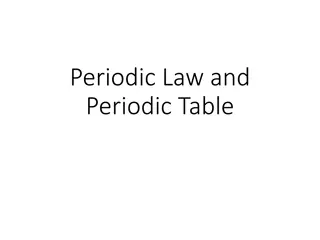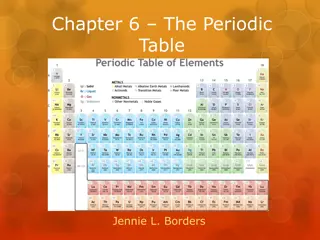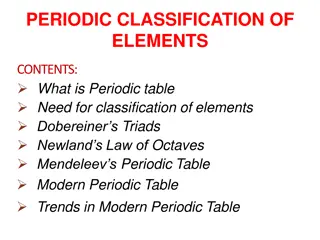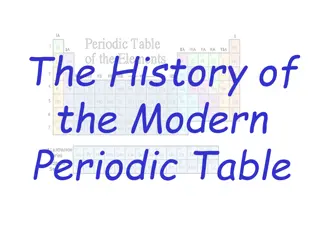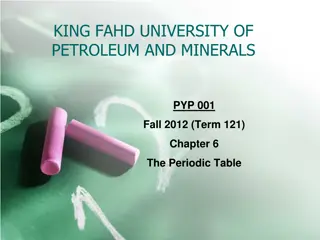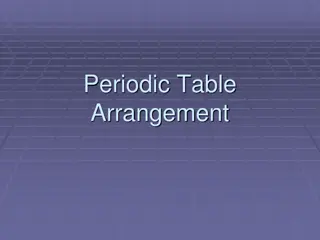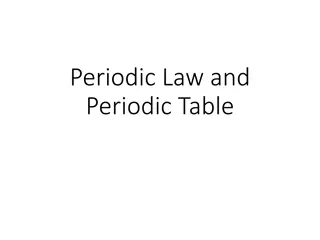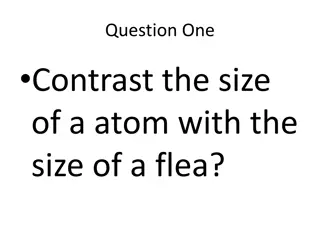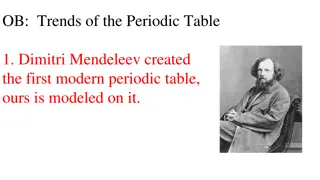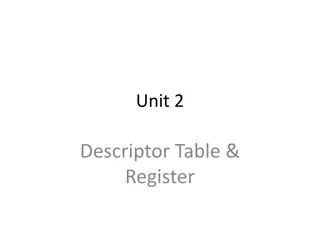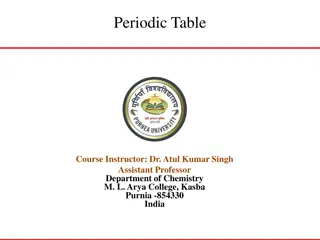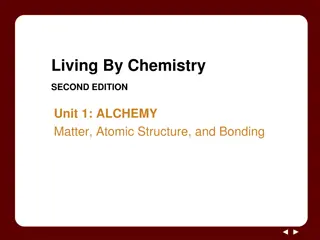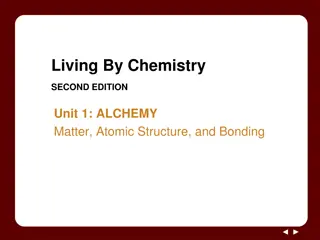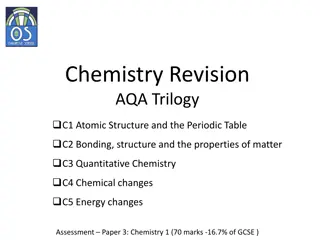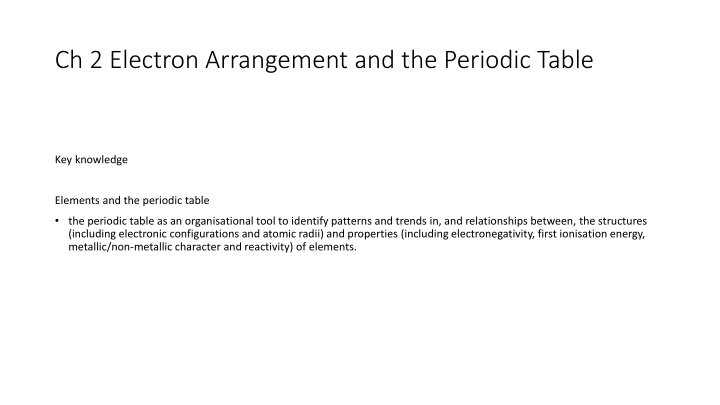
Electron Arrangement and Periodic Table Organization
Explore the significance of the periodic table as a tool to analyze electron configurations, atomic radii, and properties like electronegativity and reactivity. Learn about groups and periods, elements' electronic configurations, and the ordering of the periodic table for identifying patterns. Discover the key features of the modern periodic table and the importance of atomic number and electron distribution in chemical reactions.
Download Presentation

Please find below an Image/Link to download the presentation.
The content on the website is provided AS IS for your information and personal use only. It may not be sold, licensed, or shared on other websites without obtaining consent from the author. If you encounter any issues during the download, it is possible that the publisher has removed the file from their server.
You are allowed to download the files provided on this website for personal or commercial use, subject to the condition that they are used lawfully. All files are the property of their respective owners.
The content on the website is provided AS IS for your information and personal use only. It may not be sold, licensed, or shared on other websites without obtaining consent from the author.
E N D
Presentation Transcript
Ch 2 Electron Arrangement and the Periodic Table Key knowledge Elements and the periodic table the periodic table as an organisational tool to identify patterns and trends in, and relationships between, the structures (including electronic configurations and atomic radii) and properties (including electronegativity, first ionisation energy, metallic/non-metallic character and reactivity) of elements.
What do you know? Annotate this onto your periodic table What is a group? What info does it tell you about the electronic configuration? What is a period? What info does it tell you about the electronic configuration? What groups do these group names relate to? Alkali Metals Alkaline Earth metals Transition metal elements Halogens Noble Gases Lathanides and Actinides How is the periodic table ordered? What does mass number and atomic number represent? How do you find out the number of sub atomic particles in each atom? Where is the s,p,d and f block on the periodic table?
2.1 The Periodic Table Mendeleev
the periodic table as an organisational tool to identify patterns and trends in, and relationships between, the structures (including electronic configurations and atomic radii) and properties (including electronegativity, first ionisation energy, metallic/non-metallic character and reactivity) of elements. The Modern Periodic Table The number of protons (the atomic number) is what makes each element fundamentally different from another element. The elements in the periodic table are therefore arranged in rows in order of increasing atomic number. We use the number of electrons in the valence shell (the outer shell) to organize elements into columns. The modern periodic table has several key features The table is arranged in order of increasing atomic number The horizontal rows are known as periods and are labelled 1-7 The vertical columns are known as groups and are labelled 1-18
the periodic table as an organisational tool to identify patterns and trends in, and relationships between, the structures (including electronic configurations and atomic radii) and properties (including electronegativity, first ionisation energy, metallic/non-metallic character and reactivity) of elements. Groups of Elements The electrons in the valence shell of an atom are the electrons that are involved in chemical reactions, because of this the number of electrons determines many of the chemical properties that an element exhibits. All alkali metals are elements in group 1 (except hydrogen), they are soft metals that are highly reactive with water and oxygen. The electronic configurations for these metals are Li 1s2 2s1 Na 1s2 2s2 2p6 3s1 K 1s2 2s2 2p6 3s2 3p6 4s1 The valence shell of each atom of each element in group 1 contains one electron in an s-subshell. The similarity in the valence shell electron gives these elements similar chemical properties.
Fluorine, chlorine, bromine and iodine are halogens (group 17). They are all coloured and highly reactive. Their electronic configurations are 1s2 2s2 2p5 Fl 1s2 2s2 2p6 3s2 3p5 Cl 1s2 2s2 2p6 3s2 3p6 3d10 4s2 4p5 Br 1s2 2s2 2p6 3s2 3p6 3d10 4s2 4p6 4d10 5s2 5p5 I Notice how all these elements have the highest energy subshell electronic configuration of s2p5 (in year 10 you would have said they have 7 electrons in their valence shell. The arrangement of electrons in atoms is responsible for the periodicity (periodic pattern) of the element properties.
the periodic table as an organisational tool to identify patterns and trends in, and relationships between, the structures (including electronic configurations and atomic radii) and properties (including electronegativity, first ionisation energy, metallic/non-metallic character and reactivity) of elements. Periods The horizontal rows in the periodic table are called periods. Periods are numbered 1-7. The number of a period gives information about eh electronic configuration of an element. The period an element is located in is equal to the number of occupied electron shells the element has. 1s2 2s2 2p6 3s2 1s2 2s2 2p6 3s2 3p5 Mg Cl For both of these elements the outer shell is the 3rd shell and both of these elements are found in period 3
the periodic table as an organisational tool to identify patterns and trends in, and relationships between, the structures (including electronic configurations and atomic radii) and properties (including electronegativity, first ionisation energy, metallic/non-metallic character and reactivity) of elements. Blocks The periodic table has four main blocks. The elements in each block have the same type of subshell (s, p, d, f) as their highest energy subshell. For example, the highest energy subshell of an element in the s block is the s-subshell. The s block contains elements in group 1, group 2, hydrogen and helium. These elements all have half filled or fully filled s-subshells, that is s1 or s2 as the hightest energy subshell configuration.
the periodic table as an organisational tool to identify patterns and trends in, and relationships between, the structures (including electronic configurations and atomic radii) and properties (including electronegativity, first ionisation energy, metallic/non-metallic character and reactivity) of elements. What is shielding? The outer shell electrons are shielded from the full nuclear charge by the inner-shell electrons. Core charge allows for this shielding and is the attraction felt by the outer shell electrons to the nuclear charge. Can be calculated as atomic number minus all electrons except those in the valence shell.
Core Charge The attraction felt by the outer shell electrons to the nuclear charge. Can be calculated as atomic number minus all electrons except those in the valence shell. Down a group: remains constant but number of electron shells increases. Valence shell electrons are held less tightly. Across a period: increases as shell number remains constant. Valence shell electrons are held more tightly as there are more protons added.
the periodic table as an organisational tool to identify patterns and trends in, and relationships between, the structures (including electronic configurations and atomic radii) and properties (including electronegativity, first ionisation energy, metallic/non-metallic character and reactivity) of elements. Atomic Radius Down a group: Increases More electrons are being added and therfore shells are being filled. Shielding causes the valence electrons to be held less tightly. Across a period: Decreases More protons are being added and therefore the attraction between the electrons and protons is stronger.
Ionic Radius Radii of Cations are smaller than the parent atoms because there are more protons than electrons in the cation so the valence electrons are more strongly attracted to the nucleus. Radii of Anions are larger than the parent atoms because the extra electrons result in more repulsion between the valence electrons.
the periodic table as an organisational tool to identify patterns and trends in, and relationships between, the structures (including electronic configurations and atomic radii) and properties (including electronegativity, first ionisation energy, metallic/non-metallic character and reactivity) of elements. First Ionisation Energy First Ionisation energy: The minimum amount of energy that is required to remove one mole of electrons from one mole of atoms in the gaseous state. During this process energy is absorbed from the environment and therefore it is an endothermic process.
the periodic table as an organisational tool to identify patterns and trends in, and relationships between, the structures (including electronic configurations and atomic radii) and properties (including electronegativity, first ionisation energy, metallic/non-metallic character and reactivity) of elements. First Ionisation energy Down a group: Decreases Electrons are further away from the nucleus and can therefore be removed easily. Also atomic radii has increased Shielding effect has increased Across a period: Increases Nuclear charge increases which means that electrons are closer to the nucleus and therefore are harder to remove. Also atomic radii has decreased.
Trend in first ionization energy: exceptions There are two exceptions to the general trend in first ionization energy: both aluminium and sulfur have lower ionization energies than might be expected. 1600 ionization energy 1400 lower ionization energies than expected (kJmol-1) 1200 1000 800 600 400 Na Mg Al Si P S Cl Ar element forward_arrow_colour
First ionization energy of Al vs. Mg The first ionization energy of aluminium is less than that of magnesium, even though aluminium has a higher nuclear charge. The electron removed when aluminium is ionized is in a 3p sub- level, which is higher in energy than the 3s electron removed when magnesium is ionized. Removing an electron from a higher energy orbital requires less energy. magnesium aluminium
First ionization energy of S vs. P The first ionization energy of sulfur is less than that of phosphorus, even though sulfur has a higher nuclear charge. The highest energy electron in both phosphorus and sulfur is in the 3p sub-level. However, in sulfur this electron is paired, while in phosphorus each 3p orbital is singly occupied. Mutual repulsion between paired electrons means less energy is required to remove one of them. phosphorus sulfur
the periodic table as an organisational tool to identify patterns and trends in, and relationships between, the structures (including electronic configurations and atomic radii) and properties (including electronegativity, first ionisation energy, metallic/non-metallic character and reactivity) of elements. Electronegativity The ability of an atom that is bonded to another atom to attract the bonding electrons towards itself.
the periodic table as an organisational tool to identify patterns and trends in, and relationships between, the structures (including electronic configurations and atomic radii) and properties (including electronegativity, first ionisation energy, metallic/non-metallic character and reactivity) of elements. Electronegativity and atomic radius The electronegativity of an element depends on a combination of two factors: 1. Atomic radius As radius of an atom increases, the bonding pair of electrons become furtherfrom the nucleus. They are therefore less attracted to the positive charge of the nucleus, resulting in a lower electronegativity. higher lower electronegativity electronegativity
Electronegativity, protons and shielding 2. The number of unshielded protons The greater the number of protons in a nucleus, the greaterthe attraction to the electrons in the covalent bond, resulting in higher electronegativity. However,full energy levels of electrons shield the electrons in the bond from the increased attraction of the greater nuclear charge, thus reducing electronegativity. greater nuclear charge increases electronegativity but extra shell of electrons increases shielding.
the periodic table as an organisational tool to identify patterns and trends in, and relationships between, the structures (including electronic configurations and atomic radii) and properties (including electronegativity, first ionisation energy, metallic/non-metallic character and reactivity) of elements. Electronegativity trends: across a period Electronegativity increases across a period because: 1. The atomic radius decreases. 2. The charge on the nucleus increases without significant extra shielding. New electrons do not contribute much to shielding because they are added to the same principal energy level across the period.
the periodic table as an organisational tool to identify patterns and trends in, and relationships between, the structures (including electronic configurations and atomic radii) and properties (including electronegativity, first ionisation energy, metallic/non-metallic character and reactivity) of elements. Electronegativity trends: down a group Electronegativity decreases down a group because: 1. The atomic radius increases. 2. Although the charge on the nucleus increases, shielding also increases significantly. This is because electrons added down the group fill new principal energy levels.
the periodic table as an organisational tool to identify patterns and trends in, and relationships between, the structures (including electronic configurations and atomic radii) and properties (including electronegativity, first ionisation energy, metallic/non-metallic character and reactivity) of elements. Metallic & Non-Metallic Character Metals- usually solid, shiny, conduct electricity and heat. Non-metals- usually gases or liquids, low melting points, dull, poor conductors of heat and electricity. Across a period:Decreases Elements become less metallic as it is harder to loose valence electrons. Down a group: Increases Elements become more metallic as it is easier to loose valence electrons.
the periodic table as an organisational tool to identify patterns and trends in, and relationships between, the structures (including electronic configurations and atomic radii) and properties (including electronegativity, first ionisation energy, metallic/non-metallic character and reactivity) of elements. Reactivity Reactivity refers to the rate at which a chemical substance tends to undergo a chemical reaction. On the metallic side reactivity increases down a group as the atomic radius is larger, the first ionisation energy is lower and the electrons are further away from the nucleus being easier to loose. Francium is the most reactive element!!
the periodic table as an organisational tool to identify patterns and trends in, and relationships between, the structures (including electronic configurations and atomic radii) and properties (including electronegativity, first ionisation energy, metallic/non- metallic character and reactivity) of elements. Reactivity
The Noble gases These elements are very unreactive as they have full outer shells and therefore have very stable electronic configurations.
Trends Characteristic Trend DOWN GROUP Trend ACROSS PERIOD Atomic number and mass number Increases Increases Atomic radius Increases Decreases Melting points Decreases for groups 1 to 5 and increases for groups 15 to 18 Generally increases then decreases Reactivity Metals become more reactive and non-metals become less reactive Is high, then decreases and then increases. Group 18 elements are inert and do not react. Metallic character Increases Decreases

